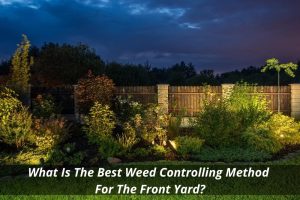Weeds are a nuisance in our yards. They take over gardens and lawns, choke out native plants, and even threaten food crops. If you want to get rid of them, you’ll need to choose the best weed control methods for your situation or you can hire local gardeners for gardening services or gardening maintenance.
Weed control has become a big issue in recent years. The problem isn’t only limited to residential areas, but also affects commercial properties such as golf courses, parks, and public spaces.
There are several ways to control weeds. Some methods include hand pulling, herbicides, manual removal, and mechanical means. Each method has its pros and cons, so it’s important to consider each option before choosing the best solution for your property.
The most common way to remove weeds is by hand pulling, which involves using one’s fingers or some sort of tool to grab the unwanted vegetation. This process can be effective if done regularly, however, it depends on the strength of the gardener who performs this task. For individuals with weak hands, this technique might not be very easy.
Herbicides and pesticides are other popular options used to kill weeds. These chemicals spray directly onto the plant and then dry up quickly after spreading. However, they’re often harmful to the environment, so you should avoid these products unless absolutely necessary.
Mechanical devices like rakes, hoes, and blowers help us eliminate weeds without damaging our surroundings. Many people use these tools to clear their gardens or landscape grasses every week.
Landscaping Fabric is an alternative that helps keep weeds at bay. It uses a mesh material that prevents soil particles from penetrating through the surface. This product is beneficial because it keeps weeds under control and protects the surrounding area.
One of the disadvantages of using Landscaping Fabric is the fact that the weed-free zone may look unsightly.
Gardens and Lawns require regular upkeep and care. Maintaining healthy lawn landscapes is essential to prevent weeds from growing and problems caused by pests, diseases, and weeds. With the right knowledge, you can keep your garden or lawn clean, green, and weed-free.
Can you control weeds with mulch?
Yes, but it’s not always possible. Mulch can play an important role in keeping weeds down, but it won’t have much effect on large perennial weeds (weeds that live for more than two years).
Mulch is usually applied around a tree trunk or other object where weeds tend to grow naturally. There are different types of mulches available; each type has different benefits and drawbacks. Here are some examples:
- Bark – Bark mulch provides nutrients for the roots and inhibits weed growth due to the decomposing effects. Bark mulch works well in shady areas and in places where there’s no access to sunlight.
- Straw – Straw mulch is made up of chopped straw and acts as an insulating layer beneath the ground. It provides warmth and moisture retention during cold weather seasons and retains heat during hot summer days. Straw mulch is commonly used in vegetable gardens.
- Wood chips – Wood chip mulch adds organic matter and nutrients to the soil. It doesn’t need any additional water compared to regular soil.
- Compost – Compost is a mixture of various organic materials including leaves, wood shavings, and manure. Once the compost is added to the ground, microbes break down the waste into rich fertilizer.
- Grass clippings – Grass clippings act as natural fertilizers when placed between rows of plants. They also help retain moisture in the soil. In addition to all these benefits, grass clippings add organic matter and nutrients to your soil.
- Manure – Manures such as cow or horse manure contain nitrogen, phosphorous, potassium, etc., that promote plant growth. You can spread manures directly on your lawn or apply them in granular form.
How do I remove weeds from my lawn?
There are many ways to get rid of unwanted weeds from your lawn. Some methods include:
- Weed Puller – Weeds can be pulled out easily if you own a weeding robot or a pair of gardening gloves.
- Hand Weeding – If you don’t want to invest in a weeding tool, you can still weed your garden with your hands.
- Bamboo Rake – The bamboo rake is designed specifically to remove weeds from lawns and garden beds. It’s lightweight and easy to maneuver.
- Manual Weed Killer – Weeds can be removed manually with a hand trowel and/or hoe.
- Herbicide Sprays & Drenches – This is the most common way to get rid of weeds in a garden. Herbicides work by killing off the weeds’ root systems, which makes them unable to produce new shoots. Most herbicides are effective against broadleaf weeds like dandelions, crabgrass, horsetail, and wild mustard.
- Aeration Equipment – Aerating equipment helps aerate the soil and loosen compacted layers. This allows air, oxygen, and water to penetrate deep into the soil, making it easier for both weeds and roots to grow.
- Rototillers – A rototiller uses an angled blade to tear through the topsoil and stir up the roots of weeds while breaking up the hardpan surface. It’s important to use a properly sized rototiller (size M) so that it won’t damage the turf.
- Power Mulchers – These machines have a spinning disk with spikes on its edge, which cuts through the topsoil. When they impact weeds, they pull them out without damaging the grass.
- Lawn Grubbers – Lawn grubbers dig small holes in the soil, allowing them to reach deeper down below the grass line.
- Lawn Seeder – Lawn seeders are very useful for seeding large areas. However, they’re not recommended for smaller plots because they can cause unevenness in the grass.
- Weed Whackers – Weed whackers work by running over the weeds, and removing their tops. They make light marks around the edges of the lawn, but don’t actually cut through the weeds.
- Water Control System – A well-designed system will allow rainwater to flow quickly away, leaving only essential water to nourish the turf.
- Planting Trimming Shears – Trimming shears are perfect for cutting back perennials along walkways and borders, preventing them from getting too tall.
- Leaf Blowers – Leaf blowers are excellent tools for clearing piles of accumulated leaves around the house.
- Tractor Attachments – There are several different attachments available for tractors that can help keep weeds under control. One example is a harrow attachment, which works by loosening the soil and pulling weeds through.
What is an effective way to keep grass from growing through concrete pavers?
One method for keeping grass from growing through large concrete pavers is to use some kind of herbicide that will kill any weeds that sprout up in between the pavers, but not harm the grass around them. You can also place a layer of mulch underneath the pavers to encourage the growth of plants that will naturally keep grass from growing through.
How does the weed control system work?
The weed control system consists of three parts: the application tool, the sprayer, and the control product itself.
Application tool
In order for the sprayer to properly apply the weed control solution, you need one that’s optimized for your needs. The type of tool you use depends on how many areas you want to cover, what season it is, whether there are obstacles, whether the area has been recently treated, and many other factors.
Sprayer
A sprayer comes equipped with all the necessary features to ensure proper application. If you choose to purchase this piece separately, you’ll be able to customize it as needed. Some models include various options such as adjustable nozzles, variable rates, and timers. This ensures that you get the right dose at the right time for optimal results.
Control Product
Choosing the correct control product requires knowledge about the chemistry involved. It should contain either glyphosate or dicamba, depending on the type of grass you wish to target. If you plan to plant annuals in the same bed after using the weed control system, we recommend applying a preemergence herbicide that will prevent these weeds from emerging.
Prevention
If possible, you should take steps before planting to prevent weeds from coming up in the first place. For example, a thick covering of straw or mulch will discourage weeds from growing while the ground is still loose.
Weeds may emerge later, so if you’ve already planted them into the soil, you’ll need to rely on a more traditional method until those plants have grown enough to provide adequate coverage of roots. Preemergent herbicides can be used when planting new seedlings, but they must be applied to the soil before the weed seeds are planted. While pre-emergents do kill existing weeds, they won’t stop the growth of new ones.
Does water damage cause weed growth?
Water damage to turfgrass can affect its health. When the soil becomes wet for extended periods of time, the grass cannot absorb nutrients well. This leads to poor quality and slow growth.
In addition, water damage disrupts the natural balance of microorganisms in the soil, causing harmful bacteria and fungi to thrive in the affected areas. To avoid water damage, water appropriately and regularly during dry weather.

